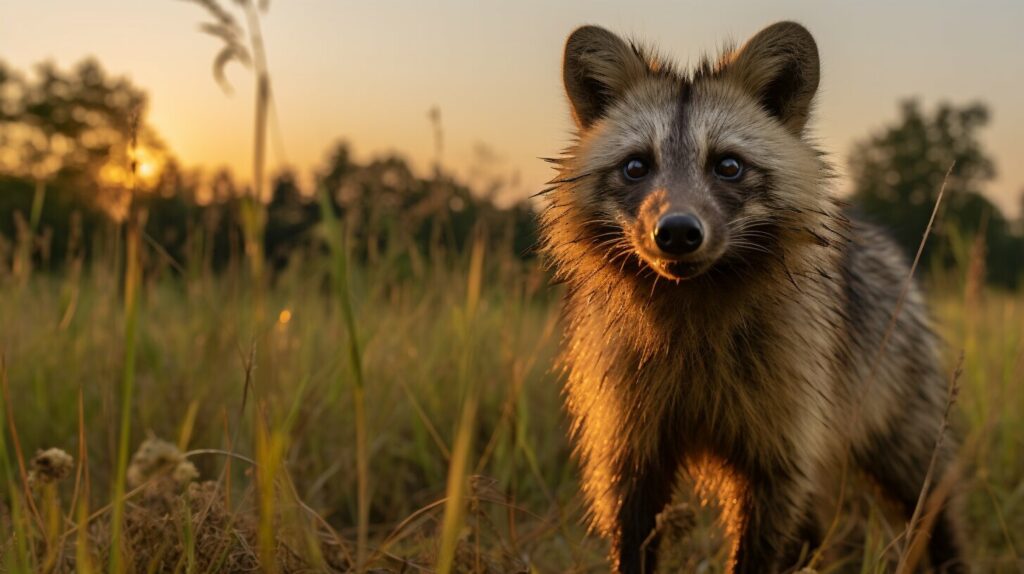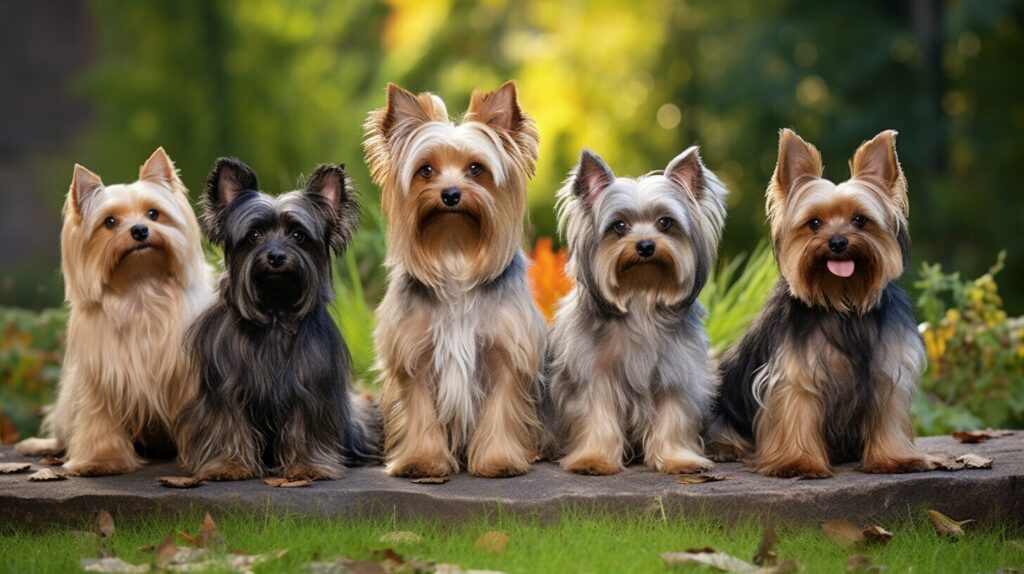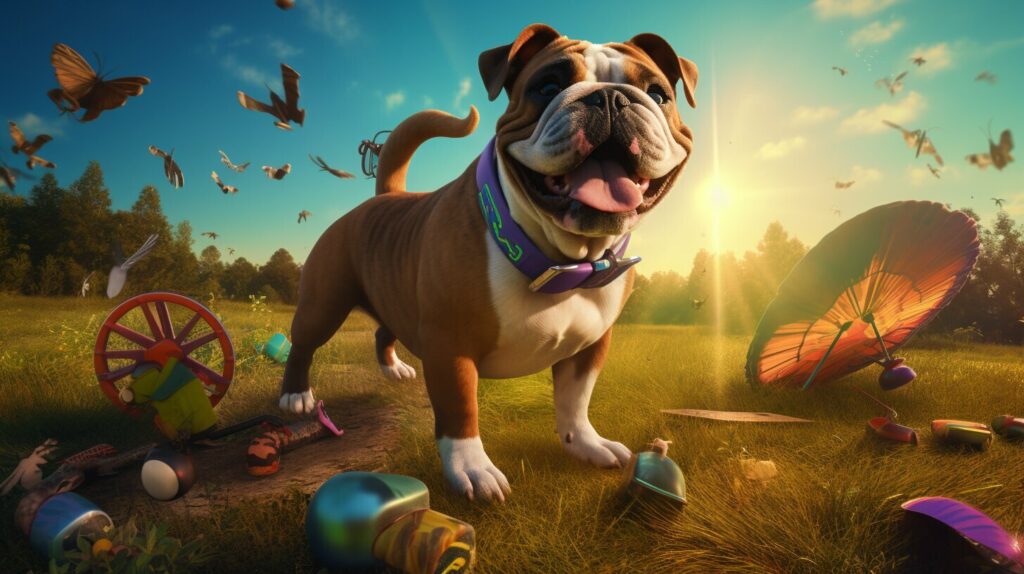Have you ever heard of raccoon dogs? These fascinating creatures are native to East Asia and have recently gained popularity in the West due to their unique appearance and behavior. In this article, we will delve into the world of raccoon dogs and provide you with informative insights into their habitat, diet, behavior, and conservation status. We will also explore the different species of raccoon dogs and showcase visually appealing images of these elusive animals in their natural habitat.
Key Takeaways:
- Raccoon dogs are native to East Asia and have unique physical features.
- They prefer living in wetlands, forests, and farmlands.
- Raccoon dogs are opportunistic omnivores and feed on a variety of food sources.
- They are social animals with complex communication systems and behavioral patterns.
- Raccoon dogs are currently facing threats such as habitat loss and hunting, and efforts are being made to conserve their populations.
Exploring Raccoon Dog Facts
As you dive deeper into the world of raccoon dogs, you’ll discover a few curious facts about these fascinating creatures. Raccoon dogs, also known as Nyctereutes procyonoides, are a type of canid native to East Asia. Here are a few more raccoon dog facts that might pique your interest:
- Raccoon dogs are not actually raccoons: despite their name, raccoon dogs are not related to raccoons at all. Their name comes from their raccoon-like markings and their physical resemblance to raccoons.
- Raccoon dogs are omnivores: raccoon dogs are opportunistic feeders and will eat just about anything they can find, including small animals, insects, fruits, and even human garbage.
- Raccoon dogs are crepuscular: which means they are most active during dawn and dusk hours.
- Raccoon dogs are social animals: living in groups of up to 12 individuals.
- Raccoon dogs have a unique trait: they can climb trees, despite being canids. In fact, they are the only canids that can climb trees.
These are just a few of the raccoon dog facts that make them such interesting creatures. Keep reading to learn even more about these elusive canids.
Raccoon Dog Habitat
Raccoon dogs are native to eastern Asia, including Japan, China, and Russia. They can also be found in parts of Europe where they were introduced in the 20th century, such as Finland, Poland, and Estonia. These animals are highly adaptable and can thrive in a variety of habitats, including forests, grasslands, and wetlands.
While raccoon dogs are known for being able to live in various environments, they do have particular preferences when it comes to their habitat. They tend to favor areas with dense vegetation, such as forests with a mix of deciduous and coniferous trees. Raccoon dogs also prefer to live near water sources, such as rivers or lakes.
In their native ranges, raccoon dogs typically make their dens in hollow trees, rock crevices, or underground burrows. They are known for being excellent climbers and swimmers, which allows them to access a wider range of habitats and sources of food.
Despite their adaptability, raccoon dogs have faced habitat loss and fragmentation due to human activities such as deforestation and urbanization. As a result, conservation efforts have been put in place to protect their natural habitats and ensure their survival.
The Diet of Raccoon Dogs
Raccoon dogs are omnivores, meaning they eat a variety of foods. Their diet varies throughout the year, depending on the availability of food in their habitat.
In the warmer months, raccoon dogs primarily feed on insects, amphibians, and small mammals such as mice and voles. They also eat berries, fruits, and other vegetation.
During the fall and winter, raccoon dogs shift their diet to include a higher percentage of plant matter, such as nuts and seeds. They also scavenge for carrion and consume small mammals such as rabbits.
Raccoon dogs are opportunistic hunters and will eat whatever food is available to them. They have been known to raid bird nests and chicken coops, and even eat garbage in urban areas.
Interestingly, raccoon dogs have a unique ability to digest a wide variety of foods, including some that are toxic to other animals, such as acorns and mushrooms.
Hunting Techniques
Raccoon dogs are skilled hunters and use a variety of techniques to catch their prey. They have strong jaws and sharp teeth that allow them to catch and kill small animals.
When hunting rodents, raccoon dogs will dig a hole near a rodent burrow and use their long, flexible paws to grab the prey. They are also capable of climbing trees to catch birds and their nests.
In addition to hunting, raccoon dogs are also proficient at scavenging for food. They will scavenge carrion and feed on leftovers from other predators.
Understanding Raccoon Dog Behavior
Raccoon dogs are known for their fascinating behavior and social structures. These creatures are highly adaptable and can thrive in a variety of environments. They are also known for their vocalizations, which range from soft whines to aggressive barks.
Raccoon dogs are primarily nocturnal animals and spend most of their day sleeping. They are active at night and use their keen sense of smell and hearing to locate prey. Raccoon dogs are omnivores and have a varied diet consisting of small animals, fruits, and vegetables. They are skilled hunters and can catch prey in both land and water.
Social Structure
Raccoon dogs are highly social animals and live in large groups. They have a hierarchical social structure, with dominant individuals leading the group. The dominant male and female in the group are typically the only ones that breed, with other members of the group helping to care for the young.
Raccoon dogs are also known for their grooming behavior. They spend a significant amount of time grooming themselves and each other. This behavior helps to reinforce social bonds within the group and helps to remove parasites from their fur.
Reproductive Habits
Raccoon dogs typically mate in the early spring and give birth to litters of 4-6 pups. The pups are born blind and helpless and are cared for by the mother and other members of the group. The young will stay with the group until they are old enough to breed, at which point they will leave to form their own group.
Raccoon dogs are also known for their unique reproductive strategy. They are able to delay implantation of fertilized eggs for up to 60 days, allowing them to give birth during the most favorable environmental conditions.
Communication
Raccoon dogs use a variety of vocalizations and body language to communicate with each other. They produce a range of sounds including whines, growls, and barks. These vocalizations are used to communicate with other members of the group, as well as to warn off potential predators.
Raccoon dogs also use body language to communicate. They have a variety of postures and facial expressions that can signal aggression, submission, or fear.
Overall, raccoon dogs are fascinating creatures with complex social structures and behaviors. Their ability to adapt to different environments and their unique reproductive strategies make them an important species to study and protect.
Key Characteristics of Raccoon Dogs
Raccoon dogs are a fascinating species with a unique set of characteristics that set them apart from other animals. Here are some specific traits that make raccoon dogs stand out:
| Characteristic | Description |
|---|---|
| Fur | Raccoon dogs have thick, soft fur that is brown or gray in color. They also have distinct facial markings, including a black mask around the eyes. |
| Size | Adult raccoon dogs typically weigh between 4-10 kilograms and measure about 50-60 centimeters in length, with a bushy tail that adds another 20-25 centimeters. |
| Diet | Raccoon dogs are omnivorous, meaning they eat both plants and animals. They primarily feed on small mammals, fish, insects, and fruits. |
| Nocturnal | Raccoon dogs are primarily active at night, hunting and foraging during the darkness and resting during the day. |
| Social Structure | Raccoon dogs are solitary creatures, but they occasionally form pairs or small groups during mating season or when raising young. |
| Reproduction | Raccoon dogs mate once a year in the winter months, with females giving birth to litters of 4-8 pups in the spring. |
These unique characteristics make raccoon dogs an important species to study and protect in their natural habitat. By understanding their behaviors, characteristics, and needs, we can ensure their continued survival for generations to come.
Conservation Status of Raccoon Dogs
Raccoon dogs face numerous challenges that threaten their survival and have led to a vulnerable conservation status. The primary threat comes from habitat destruction, as humans continue to encroach upon their natural range. Additionally, the fur trade has contributed heavily to their decline, with raccoon dog pelts being in high demand in some parts of the world.
Conservation efforts are underway to address these issues and protect the remaining raccoon dog populations. One such effort is the establishment of protected areas, where raccoon dogs can live and breed without interference from human activities. These protected areas can take many forms, from national parks to privately owned lands set aside for conservation.
Another important conservation issue for raccoon dogs is the control of invasive species that compete with them for resources. Invasive species such as the American mink can outcompete raccoon dogs for food and prey on their young, further reducing their already dwindling populations.
Conservation Organizations and Initiatives
There are several organizations and initiatives dedicated to studying and protecting raccoon dogs. Among them is the Raccoon Dog Conservation Center, which conducts research on raccoon dog behavior and ecology and advocates for their conservation.
The International Union for Conservation of Nature (IUCN) has also listed the raccoon dog as a species of “Least Concern” on their Red List, noting the importance of conservation efforts to maintain their populations.
By supporting these organizations and initiatives, you can help protect the future of raccoon dogs and ensure that these unique and fascinating animals continue to thrive in the wild.
Different Species of Raccoon Dogs
Raccoon dogs are fascinating creatures found across different regions of the world. There are several species and subspecies of raccoon dogs that have been identified, each with their own unique characteristics and traits. Here are some of the different species of raccoon dogs you may come across:
| Species | Description |
|---|---|
| Alopex lagopus | This subspecies is found in Europe and parts of Asia, and is commonly known as the Arctic fox. It has a white coat during the winter months to blend in with its snowy environment, and a brown coat during the rest of the year. |
| Nyctereutes procyonoides | This is the most well-known and widespread species of raccoon dogs, found in many parts of Asia and Europe. It is characterized by its distinct facial markings and long fur. |
| Nyctereutes procyonoides viverrinus | This subspecies is found in Japan and is known for its smaller size and lighter coat color. It also has a longer tail than other raccoon dog species. |
| Nyctereutes procyonoides koreensis | Found in Korea, this subspecies has a shorter coat and is larger in size than other raccoon dog species. It is also known for its distinctive facial markings. |
As you can see, raccoon dogs come in different shapes and sizes depending on their species and where they are found. Each one is unique and plays a vital role in its ecosystem.
Captivating Images of Raccoon Dogs
If you are fascinated by the unique appearance and behaviors of raccoon dogs, you’ll enjoy taking a closer look at these captivating images. From their fluffy tails to their distinctive facial markings, raccoon dogs are a visually striking species that are sure to catch your eye.
These images showcase raccoon dogs in their natural habitat, highlighting their adaptable nature as they climb trees, swim in rivers, and hunt for food. You’ll also get a glimpse into their social interactions, as raccoon dogs often live in family groups and communicate through a wide range of vocalizations and body language.
Whether you are a nature enthusiast, a wildlife photographer, or simply curious about these mysterious creatures, these raccoon dog images offer a unique glimpse into their world. So sit back, relax, and enjoy these stunning photographs of raccoon dogs in action.
Further Information on Raccoon Dogs
If you are interested in learning more about raccoon dogs, there are numerous resources available that can provide in-depth information on these fascinating creatures.
Books such as “Raccoon Dogs: Mischievous and Clever” by S. Yamamoto and “Raccoon Dogs as Pets and Their Characteristics” by T. Kusaka offer valuable insights into the behavior, habitat, and characteristics of raccoon dogs.
Online resources such as the Raccoon Dog Conservation Group and the IUCN Red List provide the latest information on the conservation status of raccoon dogs, as well as ongoing efforts to protect them.
If you are interested in observing raccoon dogs in their natural habitat, guided wildlife tours in countries such as Japan and Russia provide excellent opportunities to view these elusive animals up close.
Whether you are a nature enthusiast or simply curious about raccoon dogs, these resources can help you gain a deeper understanding of these enigmatic creatures.
How Raccoon Dogs Captivate the Imagination
Raccoon dogs are not only captivating creatures in the wild, but they also hold a special significance in folklore and pop culture. These fascinating animals are often depicted in Japanese folklore as mischievous tricksters, and are known as “tanuki.” In these tales, the tanuki are portrayed as shape-shifting tricksters who use their supernatural powers to play pranks on humans and other animals.
The presence of raccoon dogs in popular culture is not just limited to Japan. These animals have also appeared in various forms of media around the world. For example, in the Nintendo game series, “Super Mario Bros. 3,” a power-up called the Super Leaf gives the player the ability to transform into a raccoon, paying homage to the tanuki of Japanese folklore.
How Raccoon Dogs Captivate the Imagination in Popular Culture
| Media Type | Example |
|---|---|
| Video Games | Super Mario Bros. 3 |
| Film | Pom Poko (1994) |
| Art | “Tanuki Sleeping in a Tree Hollow” painting by Maruyama Okyo (18th century) |
Despite their cultural significance, raccoon dogs are often misunderstood and even subject to mistreatment. In some countries, these animals are hunted for their fur or used as pets, despite the fact that they are not well-suited for domestication. It is important that we continue to educate ourselves and others about the true nature of raccoon dogs, and work towards their conservation and protection in the wild.
By learning about the behavior, characteristics, and ecology of raccoon dogs, we can appreciate these unique animals for the incredible creatures they are, and work towards ensuring their survival and continued presence in our natural world.
Unraveling the Enigma: A Final Word on Raccoon Dogs
You now have a comprehensive understanding of raccoon dogs and their unique characteristics, behaviors, and habitats. From their captivating appearance to their fascinating social structure, raccoon dogs truly are an intriguing species.
Remember that raccoon dogs are not domesticated animals and should not be kept as pets. If you encounter a raccoon dog in the wild, it is important to maintain a safe distance and observe from afar.
Despite their elusive nature, raccoon dogs have captivated the imagination of individuals across cultures, inspiring artwork, stories, and even video games. As you continue to learn about these fascinating animals, consider the important role they play in their ecosystems and the efforts being made to protect them.
If you want to learn more about raccoon dogs, there are many resources available, including books, websites, and organizations dedicated to their study and conservation. Take the time to explore these resources and deepen your understanding of these enigmatic creatures.
FAQ
Q: What are raccoon dogs?
A: Raccoon dogs are a species of mammal native to East Asia. Despite their name, they are not actually raccoons or dogs, but belong to the canid family.
Q: Where do raccoon dogs live?
A: Raccoon dogs are primarily found in East Asia, including countries like Japan, China, and Korea. They inhabit a variety of habitats, including forests, grasslands, and wetlands.
Q: What do raccoon dogs eat?
A: Raccoon dogs are omnivorous and have a diverse diet. They feed on a combination of plant matter, insects, small mammals, birds, and fish.
Q: What is the behavior of raccoon dogs like?
A: Raccoon dogs are primarily nocturnal and solitary creatures. They are known for their excellent climbing and swimming abilities. Mating season usually occurs in late winter or early spring.
Q: What are the key characteristics of raccoon dogs?
A: Raccoon dogs have a unique appearance with their thick fur, pointed snouts, and distinctive facial markings. They also have a bushy tail and retractable claws.
Q: What is the conservation status of raccoon dogs?
A: Raccoon dogs are currently listed as a species of “Least Concern” by the International Union for Conservation of Nature (IUCN). However, habitat loss and hunting pose threats to their populations.
Q: How many species of raccoon dogs are there?
A: There are six recognized subspecies of raccoon dogs, each found in different regions of East Asia. These subspecies vary in size and appearance.
Q: Can I find images of raccoon dogs?
A: Yes, you can find captivating images of raccoon dogs in their natural habitat. These images provide a visual representation of their unique features and behaviors.
Q: Where can I find more information about raccoon dogs?
A: If you want to explore further information about raccoon dogs, there are various resources available such as books, websites, and organizations dedicated to the study of these fascinating creatures.



